Background: Beta-thalassemia syndromes are a category of genetic blood disorders defined by reduced or incomplete beta globin chain synthesis, leading to lower hemoglobin levels in red blood cells (RBC), lower RBC output, and anemia.
Aims and objectives: To study the growth pattern in thalassemic children who are on regular chelation therapy and blood transfusion in comparison to normal children and serum ferritin level in these children and its relation to growth pattern and oral chelation therapy.
Methods: The present study was a hospital-based cross-sectional study. One hundred and one transfusion-dependent thalassemic children on oral chelation therapy, attending the pediatric ward in Gauhati Medical College and Hospital, Guwahati, Assam, were enrolled during the study period from 1st May 2021 to 30th April 2022.
Results: This study provides evidence that children suffering from transfusion-dependent thalassemia (TDT) are prone to growth retardation, with underweight, stunting, and wasting being 31.6%, 52.4%, and 27.7%, respectively.
Conclusion: In conclusion, short stature is an important complication in TDT. Growth in patients with TDT is significantly related to age, sex, hemoglobin level, and iron overload status. Management with hypertransfusion and good control of iron overload is important to achieve optimum growth in patients with TDT.
Beta-thalassemia syndromes are a group of genetic blood disorders characterized by reduced or incomplete beta globin chain synthesis, leading to lower hemoglobin levels in red blood cells (RBC), lower RBC output, and anemia [1]. The harmful effects of excess globin chain subunits can be attributed to the pathophysiology of thalassemias. Excess chains affect red cell precursors and red cells, leading to erythropoietic marrow enlargement that is ineffective in creating mature red cells, severely impairing development, bone formation, and growth. Iron deposition on the endocrine organs, liver, and heart, which occurs from increased intestine absorption and the consequences of blood transfusion, is the primary cause of morbidity and mortality [2].
According to the Census of India 2011, the average prevalence of \(\beta\) thalassemia carriers is 3-4%, which equates to 35 to 45 million carriers in the multi-ethnic, culturally, and linguistically diversified population of 1.21 billion people, including roughly 8% of tribal communities [3,4,5]. Diagnosis of thalassemias requires a combination of laboratory tests, including automatic hematology analyzer evaluation of red blood cell indices, Hb analysis, and quantification of Hb A2 and Hb F. The thalassemic disorders and carriers can be distinguished using high-performance liquid chromatography (HPLC) and capillary zone electrophoresis (CE) system [6].
Patients with thalassemia major (TM) typically exhibit delayed puberty and development, along with a decrease in ultimate height. Despite significant advancements in therapy, growth failure in TM has long been recognized. Up to the age of 9 to 10 years, the child with TM has a specific development pattern that is quite typical; after this age, a slowdown of growth velocity and a diminished or non-existent pubertal growth surge are noticed. The fusing of the growth plates often takes place at the end of the second decade of life [7, 8].
The causes of growth failure are complex and multifaceted, mainly due to chronic anemia, hypoxia, chronic liver disease, zinc and folic acid deficiency, iron overload, intensive use of chelating agents, emotional factors, endocrinopathies, and GH-IGF-1 axis dysregulation [8]. Early-life high serum ferritin levels are linked to eventual short stature, suggesting that iron chelation treatment can prevent or reduce this issue [8,9,10].
This study aims to investigate two important aspects related to growth patterns in thalassemic children:In this study, the average age of the participants was found to be 7.6\(\pm\)2.6 years, with the youngest participant being 1 year old and the oldest being 13 years old (Figure 1). Among the 101 transfusion-dependent thalassemic children, the majority (70.2%) were male. The average age at diagnosis was 22.7\(\pm\)10.1 months, with the youngest case being diagnosed at 7 months and the oldest at 44 months. The average pre-transfusion Hb level was 6.3\(\pm\)1.5 gm/dL (Figure 2). Out of the 101 children in the study, 24 (23.7%) had serum ferritin levels greater than 2000 \(\mu\)g/L, and the majority of them (79.1%) were over 8 years old. In contrast, 43 (42.5%) children had serum ferritin levels below 1000 \(\mu\)g/L, and only 11 (25.5%) of them were over 8 years old (Figure 3). Of the 101 children in the study, 32 (31.6%) were underweight according to WHO and IAP charts by age. Of these, 20 (46.5%) were over 8 years old. The percentage of underweight children was 26.4%, 14.2%, and 0% for age groups 5-8 years, 2-5 years, and under 2 years old, respectively (Figures 4 and 5). Among the 101 transfusion-dependent thalassemic children, 53 (52.4%) were stunted according to WHO and IAP charts by age. Of these, 33 (76.7%) were over 8 years old. The percentage of stunted children was 44.1%, 23.8%, and 0% for age groups 5-8 years, 2-5 years, and under 2 years old, respectively. Among the 24 transfusion-dependent thalassemic children in the age group of 1-5 years in our study, 3 (12.5%) were found to be wasted, and all three belonged to the age group of 2-5 years old. None of them were below 2 years old.
Out of the 24 children with serum ferritin levels above 2000 \(\mu\)g/L, 21 (87.5%) were found to be underweight. Of the 34 children with serum ferritin levels between 1000-2000 \(\mu\)g/L, 6 (17.6%) were underweight. Only 5 (11.6%) children out of 43 whose serum ferritin levels were below 1000 \(\mu\)g/L were underweight (Figure 6). The correlation coefficient (r) was found to be 0.6899, with a 95% confidence interval of 0.5715 to 0.7802. The two-tailed P value was less than 0.0001, which was considered extremely significant.
In this study, all 24 children with Serum Ferritin Levels above 2000 \(\mu\)g/L were found to be stunted, while 26 (76.4%) out of 34 children with levels between 1000-2000 \(\mu\)g/L were stunted. Only 2 (4.6%) out of 43 children with Serum Ferritin Levels below 1000 \(\mu\)g/L were stunted (Figure 7). The correlation coefficient (r) is 0.802, with a 95% confidence interval of 0.7179 to 0.8615, and the two-tailed P value is < 0.0001, which is considered extremely significant.
Regarding wasted children, 12 (50%) out of 24 children with Serum Ferritin Levels above 2000 \(\mu\)g/L were found to be wasted, while 8 (27.5%) out of 29 children with levels between 1000-2000 \(\mu\)g/L were wasted. Only 6 (25%) out of 24 children with Serum Ferritin Levels below 1000 \(\mu\)g/L were wasted (Figure 9). The two-tailed P value is 0.2881, which is considered not significant. For children with Serum Ferritin Levels between 1000-2000 \(\mu\)g/L, 1 (20%) out of 5 children was wasted, while only 2 (10.5%) out of 19 children with levels below 1000 \(\mu\)g/L were wasted. None of the children below 5 years of age had Serum Ferritin Levels above 2000 \(\mu\)g/L (Figure 8). The two-tailed P value is 0.0184, which is considered significant with a 95% confidence interval of 0.09117 to 0.7384.
In terms of Mid Upper Arm Circumference (MUAC), only 1 child with Serum Ferritin Level below 1000 \(\mu\)g/L had MUAC below 11.5 cm, while no other child had MUAC below this level. The correlation coefficient (r) is -0.046, with a 95% confidence interval of -0.4485 to 0.3564, and the two-tailed P value is 0.7987, which is considered not significant.


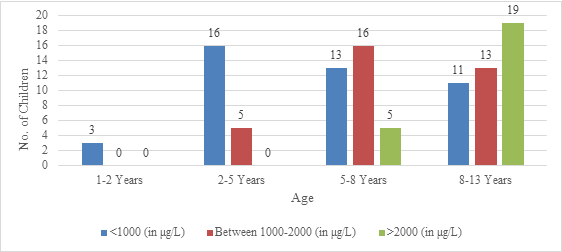
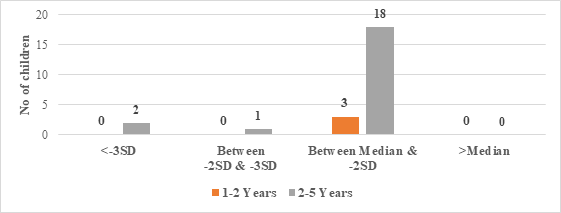

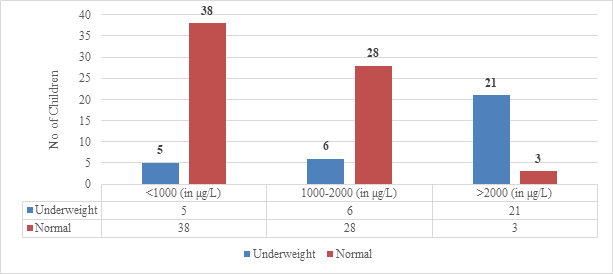
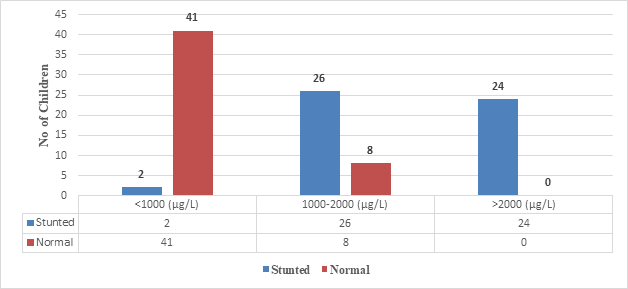
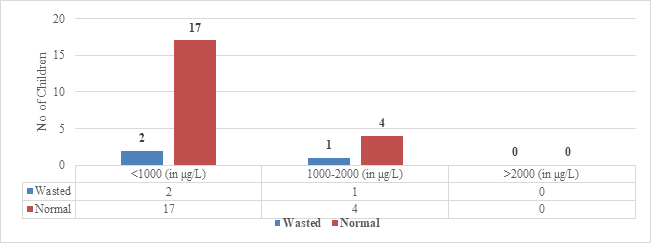

The mean pre-transfusion hemoglobin level in this study was 6.3\(\pm\)1.5 gm/dL, which is well below the recommended level of 10 gm% [11] for adequate growth of thalassemic children. 83.2% of the children in the study had pre-transfusion hemoglobin levels of less than 8 gm%. Similar results were found in other studies, such as those conducted by Pemde et al. in New Delhi, India [12] (9.21 g/dL), and Nokeaingtong et al. in Chiang Mai University Hospital, Thailand [13](7.4\(\pm\)1.0 g/dL).
Overall, 31.6% of the children in this study were underweight, with underweight being more prevalent with increasing age. There was a strong statistical correlation between underweight and increasing age, which is consistent with observations in other studies, such as those conducted by Moiz et al. in Karachi, Pakistan [14] (40%), Rathaur et al. in Uttarakhand, India [15] (77%), and Chhabra and Sodhi in Punjab, India [16] (78.1%).
In this study, 52.4% of the children were found to be stunted, with stunting being more prevalent in patients over the age of 8 years and approximately half of those between 5-8 years. Therefore, stunting was found to be more prevalent with increasing age. Similar observations were seen in studies conducted by Nokeaingtong et al. in Chiang Mai University Hospital, Thailand [13] (38%) and Moiz et al. in Karachi, Pakistan [14] (65.4%).
Wasting was found in 27.7% of the children in this study, with similar prevalence between the age groups of 5-8 years and 8-13 years. This observation is consistent with those of other studies, such as those conducted by Moiz et al. in Karachi, Pakistan [14] (42%) and Pemde et al. in New Delhi, India [12] (24.1%).
The present study found that 96% of the children between 1-5 years had MUAC within the normal range, indicating adequate nutrition. Among children with serum ferritin levels above 2000 \(\mu\)g/L, 87.5% were underweight, 100% were stunted, and none below the age of 5 years had serum ferritin levels above 2000. Furthermore, 50% of those over the age of 5 years were wasted. However, no correlation was established between serum ferritin and MUAC in this study.
Regarding children with serum ferritin levels below 1000 \(\mu\)g/L, 11.6% were underweight, 4.6% were stunted, and 10.5% were wasted below the age of 5 years, while 25% were wasted above the age of 5 years. The present study suggests a correlation between high serum ferritin levels and growth retardation, which is consistent with observations in similar studies, such as those conducted by Rathaur et al. in Uttarakhand, India [15], 2020, and Hala Saad Bash et al. in the University of Babylon, Iraq [17], 2021 concluded the same.
